No products in the cart.
NEWS
Cultivating Beauty and Privacy: Stunning Flowering Plants for Your Fence
Elevating your home’s exterior aesthetic and creating a personal oasis is a goal for many homeowners. One enchanting way to achieve this is by integrating flowering plants into your fence line. A living fence, adorned with vibrant blooms, transforms a simple boundary into a breathtaking feature that benefits both your property and the local ecosystem. These floral barriers can attract beneficial pollinators, provide a lush green backdrop, and inject life and color into your garden. As experts in horticulture and gardening, we understand the profound impact plants have on our living spaces and the environment. Let’s explore the incredible advantages of using flowering plants for your fence and discover some truly beautiful options perfectly suited for this purpose.
Why Choose Flowering Plants for Your Fence?
Integrating flowering plants along your fence line offers a multitude of benefits beyond simple decoration. It’s a strategic landscaping choice that enhances privacy, improves the local environment, and boosts your property’s appeal.
Enhance Curb Appeal and Aesthetics
A fence lined with blooming plants creates an immediate visual impact. Instead of a stark, uniform barrier, you get a dynamic, ever-changing display of colors, textures, and forms. This natural tapestry makes your home more inviting and creates a welcoming atmosphere for visitors and passersby. The right selection of plants can provide interest throughout the seasons, ensuring your fence remains a captivating feature year-round.
Provide Privacy and Define Boundaries
Flowering plants, especially vining or dense shrub varieties, can effectively soften the hard lines of a fence and create a sense of enclosure. They add height and depth, offering a natural screen that shields your garden and home from curious eyes. A living boundary clearly defines your property line while adding a layer of lush beauty that traditional fences alone cannot provide.
Reduce Noise
A dense planting of shrubs or vines along a fence can act as a natural sound barrier. The foliage helps to absorb and deflect noise from traffic or neighbors, contributing to a quieter and more peaceful environment within your garden and home. While not a complete soundproofing solution, it significantly helps in dampening ambient noise.
Improve Air Quality and Support Ecosystems
Plants are natural air filters, absorbing pollutants and releasing oxygen. A living fence contributes to cleaner air around your home. Furthermore, flowering plants attract pollinators like bees, butterflies, and hummingbirds, which are vital for the health of your garden and the broader ecosystem. Creating a habitat for these beneficial insects and birds supports biodiversity and brings more life into your outdoor space.
Increase Property Value
Well-executed landscaping, including attractive and functional fences, is a significant factor in increasing property value. A beautiful, flowering fence adds to the overall aesthetic appeal of your home, making it more attractive to potential buyers and demonstrating care and attention to detail.
Discover the Perfect Bloom: 8 Beautiful Flowering Fence Plants
Transforming your fence into a vibrant display of nature is an exciting project. Here are eight stunning flowering plants that are well-suited for creating a beautiful living fence, bringing color, fragrance, and life to your outdoor space.
Hydrangea (Climbing Hydrangea)
Climbing Hydrangeas are characterized by their soft, heart-shaped leaves, typically deep green. The flowers are smaller, tube-shaped, and come in various colors including green, purple, pink, white, and orange. These blooms typically appear in the morning and may last for a day before fading.
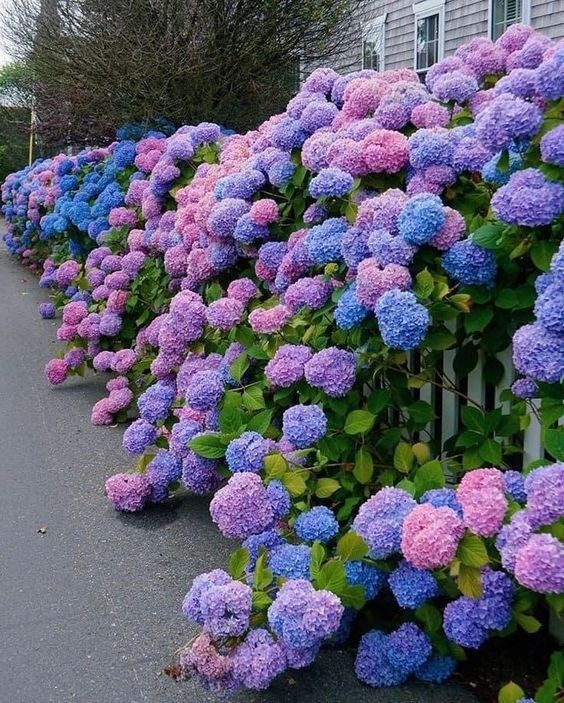 Close-up of delicate white and pink Climbing Hydrangea flowers blooming on a green vine fence
Close-up of delicate white and pink Climbing Hydrangea flowers blooming on a green vine fence
This plant has a natural ability to climb, attaching itself to structures like fences, wires, walls, or trellises. It grows rapidly, forming a beautiful floral screen. Climbing Hydrangea is often planted to create scenic backdrops for gardens, patios, balconies, or porches. It thrives in warm climates with direct sunlight and requires well-draining, nutrient-rich soil. This plant often self-seeds and can regenerate each year.
Climbing Rose
Climbing roses, as the name suggests, are varieties capable of climbing structures like fences, poles, walls, or arbors. With their refined beauty and captivating fragrance, climbing roses are a popular choice for decorating gardens and yards.
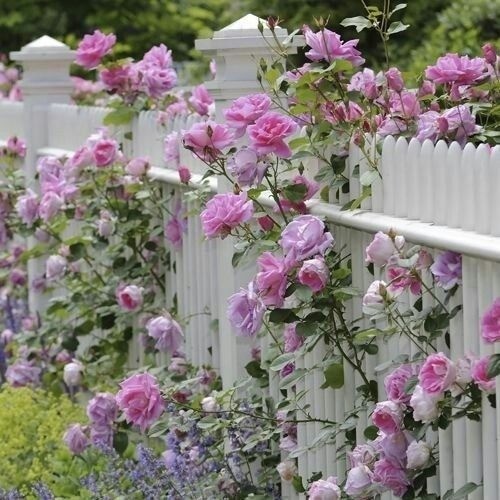 Vibrant pink Climbing Roses blooming profusely on a garden trellis or fence structure
Vibrant pink Climbing Roses blooming profusely on a garden trellis or fence structure
There is a vast diversity of climbing roses, varying widely in flower color, shape, and size. Popular types include single-color climbers, multi-colored climbers, butterfly-wing climbers, woody-stemmed climbers, and many more. Each type of climbing rose brings its own unique charm and adaptability to different growing environments. Climbing roses often bloom throughout the year, creating a spectacular and eye-catching floral display. Some varieties also boast a delightful fragrance, adding a sweet, romantic aroma to the air.
String of Pearls
The String of Pearls plant is known for its small, round, green leaves shaped like beads, resembling a string of pearls. The plant’s vines are long and delicate, offering a light and natural aesthetic. This plant is often draped over fences or walls to add beauty and create a charming boundary.
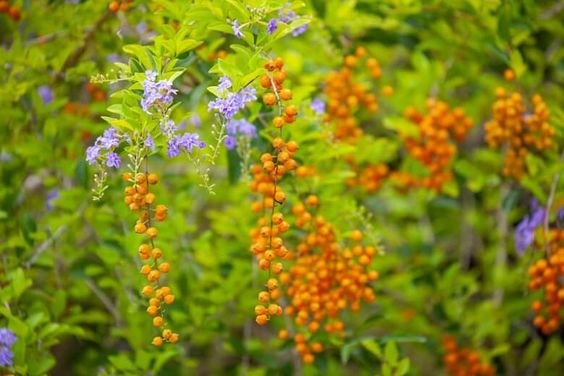 Close-up of the distinctive bead-like leaves of a String of Pearls succulent trailing over a pot rim
Close-up of the distinctive bead-like leaves of a String of Pearls succulent trailing over a pot rim
An interesting and useful trait of the String of Pearls plant is its ability to propagate itself easily. As the plant matures, its vines naturally create new roots where they touch the soil, allowing you to easily propagate new plants from the parent. This makes it simple to expand your green display.
Star Jasmine
With its intensely sweet fragrance and evening blooms, Star Jasmine is a popular choice for adorning gardens or yards and is a favored flowering fence plant. This plant creates a living space with a cool green backdrop, offering a relaxing and romantic ambiance.
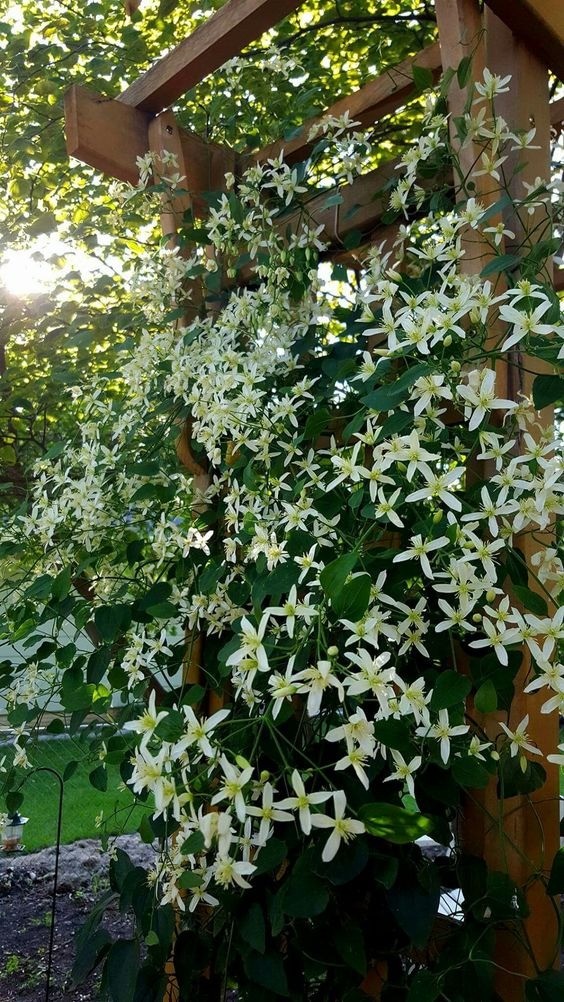 Star-shaped white flowers of Star Jasmine blooming against lush green foliage, suitable for a fence
Star-shaped white flowers of Star Jasmine blooming against lush green foliage, suitable for a fence
The plant features small, white or cream-colored flowers that are tube-shaped with long petals. The flowers have a distinctive and very fragrant scent, particularly strong in the evening, from early to mid-night, attracting insects like bees and butterflies. Star Jasmine prefers direct sunlight or bright, indirect light. The soil should have good drainage and be rich in nutrients. The plant is heat tolerant and can withstand warm climates.
Night Jessamine
Night Jessamine possesses unique characteristics, with large, heart-shaped leaves and a deep green color. Notably, it can store water in its stems, helping it endure drought and water scarcity for extended periods. This makes Night Jessamine a suitable choice for those who cannot water their plants frequently.
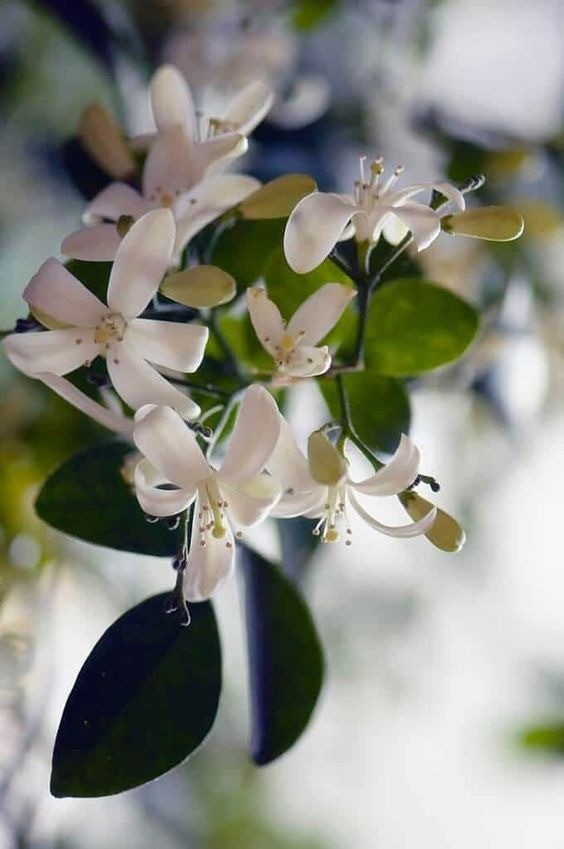 Lush green leaves and delicate white flowers of a Night Blooming Jasmine plant, often used for hedges
Lush green leaves and delicate white flowers of a Night Blooming Jasmine plant, often used for hedges
With its natural beauty and symbolic meaning of prosperity, Night Jessamine is often planted along front fences to bring a tropical aesthetic and good fortune to the living space. It is a popular choice for enhancing the landscape in front of the house, creating a tranquil and refreshing atmosphere.
Mexican Creeper (Antigonon leptopus)
Mexican Creeper flowers have triangle-shaped petals, often displaying bright and vibrant colors such as red, orange, yellow, pink, and white. Each petal typically opens for just one day, usually blooming in the morning and closing by the afternoon. Mexican Creeper creates a beautiful and eye-catching effect with the unique arrangement and color of its petals.
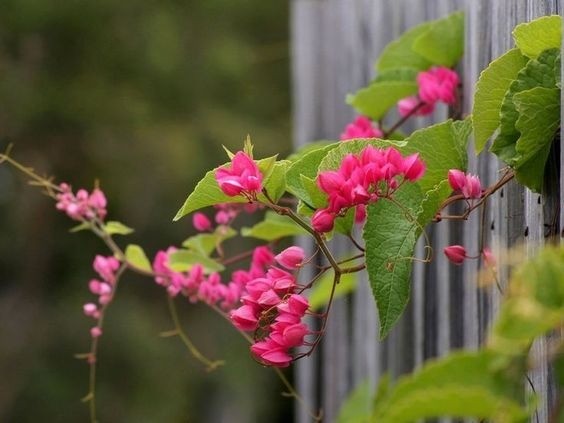 Vibrant pink flowers of Mexican Creeper (Antigonon leptopus) cascading over a fence, creating a colorful screen
Vibrant pink flowers of Mexican Creeper (Antigonon leptopus) cascading over a fence, creating a colorful screen
With its striking beauty and bright colors, Mexican Creeper is a popular choice for decorative planting. Mexican Creeper also symbolizes freshness, blooming vibrancy, and joy. It is considered a highly recommended flowering plant for fences.
Bougainvillea
Bougainvillea is one of the most popular flowering plants for front yards and fences today. The plant features small, unscented flowers surrounded by colorful bracts, which provide the vibrant display. The colors of Bougainvillea bracts are incredibly diverse, including pink, red, orange, yellow, white, and purple, creating a bright and dazzling mass of color in the garden.
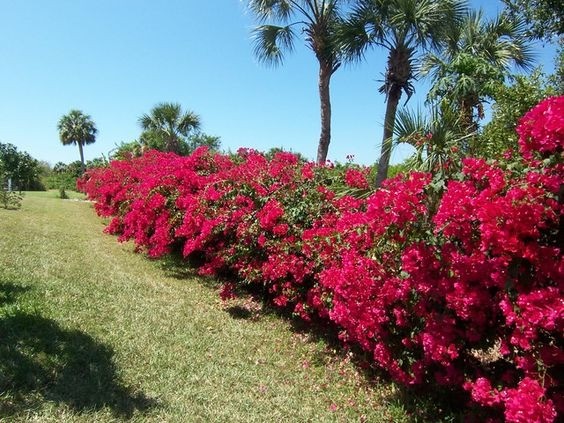 Vibrant pink and purple Bougainvillea vine in full bloom, creating a dense, colorful fence or wall covering
Vibrant pink and purple Bougainvillea vine in full bloom, creating a dense, colorful fence or wall covering
Bougainvillea is often planted as a climbing plant on fences, poles, walls, or trellises. It can also be pruned and shaped to maintain a suitable size and form for the planting space. Bougainvillea creates a prominent and lively effect in the outdoor space, bringing a dynamic and vibrant atmosphere.
Forsythia
Forsythia plants feature bright yellow flowers that bloom profusely on the branches before the leaves emerge. The tube-shaped flowers have small petals arranged in clusters, creating a radiant spectacle. Forsythia blooms in late winter and early spring, typically from February to April. This is the time when the Forsythia plant welcomes spring with its cheerful yellow blooms.
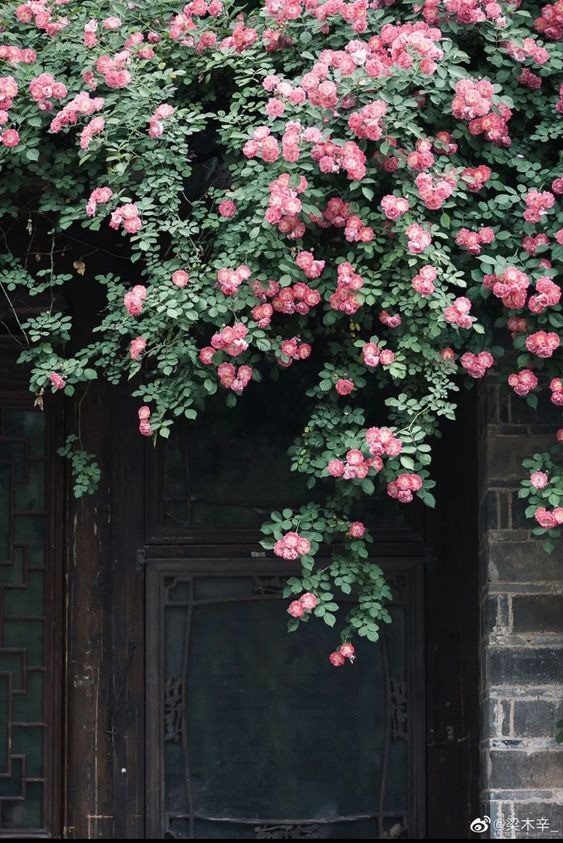 Bright yellow Forsythia flowers covering bare branches, signaling the arrival of spring on a garden border
Bright yellow Forsythia flowers covering bare branches, signaling the arrival of spring on a garden border
Forsythia is often planted as an ornamental shrub in gardens, yards, or used to create a vibrant green hedge. With its bright beauty and radiant colors, it creates a living space that welcomes spring and adds a focal point to the garden. Therefore, when looking for a flowering plant for your fence, you should definitely consider Forsythia.
Hibiscus
This species originates from tropical and subtropical regions around the world and is widely cultivated in many different climates. With its striking beauty and brilliant flowers, the Hibiscus plant is one of the most popular flowering plants for decorating exterior spaces and planting along fences.
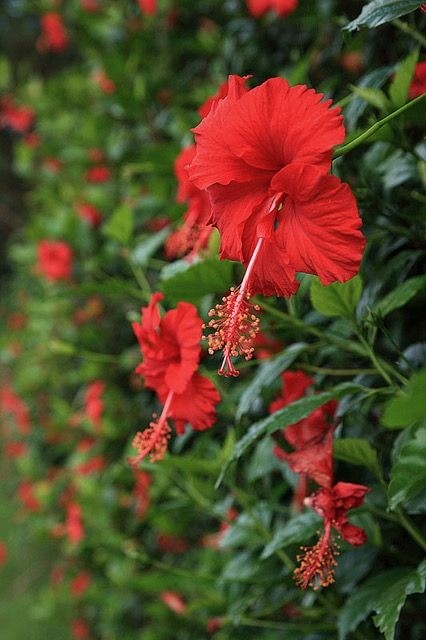 Large, bright red Hibiscus flower with prominent stamen, representative of a common flowering hedge plant
Large, bright red Hibiscus flower with prominent stamen, representative of a common flowering hedge plant
Hibiscus is often planted as an ornamental shrub in gardens, yards, or used to create hedges. It can also be grown in pots or containers to decorate balconies or porches, or cultivated as trained specimens with various shapes.
Conclusion
We’ve presented you with some exceptionally beautiful flowering plant varieties perfect for fence lines. Considering the significant benefits and the aesthetic appeal they offer, these plants are truly worth considering to enhance your home’s exterior space. Creating a living fence not only adds immense beauty but also contributes positively to your environment. Explore the possibilities and bring a touch of nature’s artistry to your property boundary. Discover more valuable insights into cultivating beautiful plants and transforming your garden with Biogarden.asia.



